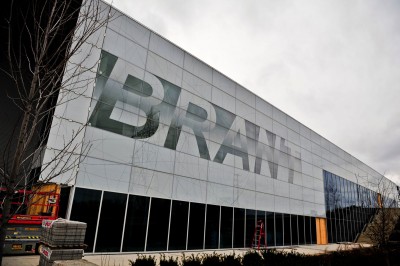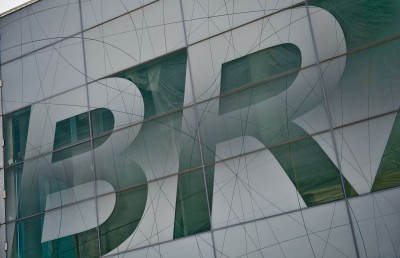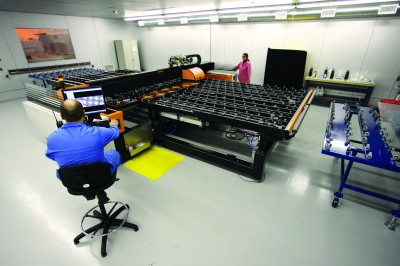By Stephen Balik
Glass has been used for centuries in windows and other ‘portals’ to create light-filled indoor spaces. Today, thanks to advances in digital technology, everything from interior partitions to small windows to entire building façades can be transformed as a signmaker’s canvas. Inkjet printer engineers have developed new tools to imprint detailed, full-colour artwork—including photographic-quality images—right onto glass surfaces, with sufficient resiliency to last for decades to come.
Digital printing on glass can create messages of virtually any size on any building’s window glazing. This opens new possibilities for the role glass can play in a building’s design and function. Text, images, wayfinding icons, logos and original works of art can now all be integrated into a building’s materials. Signage can thus become part of a building, rather than merely added to it.
The glass façade of the Brant Twin Pad Complex, an ice-skating facility in Paris, Ont., is one example of how digital printing on glass can display a building’s brand and function clearly and artfully. Intricate lines in varying hues of grey and silver flow through a pattern in the word ‘Brant,’ representing the movement of the arena’s skaters. Variations in the width of these lines suggest the transfer of pressure between skate blades.

Graphics were printed directly onto the glass façade of the Brant Twin Pad Complex, an ice-skating facility in Paris, Ont.
Since these graphics were imprinted on the glass with inks that are not fully opaque, onlookers outside can share the experience of what is going on inside the building. And in the same way, people inside the arena can look outside through the giant municipal logo.
Then and now
Traditionally, silkscreening has been the most ubiquitous technique for adding text and images to glass. Also known as ‘ceramic frit,’ the process involves applying a design by placing a screen over a piece of glass, then using a squeegee to press the design (i.e. the frit) through the screen. The frit adheres to the glass permanently as it passes through an infrared (IR) oven and tempering furnace.
Multiple screens must be used, however, to create images with more than one colour. This and other costly, labour-intensive aspects of the ceramic frit process have led the glass industry and signmakers alike to pursue other avenues for bringing graphics to the surface of glass.
Israel-based Dip-Tech, for example, which has developed printers and inks for ceramic surfaces, is now partnering with General Glass International (GGI) in Secaucus, N.J., to advance direct-to-glass technology with new products and services. Together, they are exploring the potential to change the esthetic and functional properties of glass.

Varying hues of grey and silver represent the movement of skaters at the arena. People can see through the logo from the outside or inside.
With digital direct-to-glass printing, special ceramic inks are applied to the substrate in a process similar to cyan, magenta, yellow and key/black (CMYK) inkjet printers, whereby the various inks are blended to create multiple colours. For graphics on glass, this method eliminates the extensive setup, cleaning and storage of screens. There is no need for multiple print runs, either, as all of the graphic design and editing is undertaken through computer software. Small and medium-sized jobs prove very cost-effective compared to screenprinting runs.
Another advantage is the ink. Permanently fused to the glass, it requires very little maintenance, saving money that would otherwise be spent on the upkeep of screenprinted signage. Scratchproof, ultraviolet-resistant (UV-resistant) and waterproof, the digitally produced graphics can withstand decade of wear and tear—and even protect interior spaces against harsh rays of sunlight.
Indeed, there can be additional benefits for the building and its occupants. The design team for One Reading Central, a new commercial office building in Reading, England, used thermal insulation glazing to achieve significant energy savings inside. The building received an ‘Excellent’ rating under the Building Research Establishment Environmental Assessment Method (BREEAM), a ‘green building’ evaluation system in the U.K.






